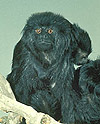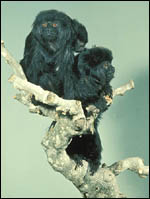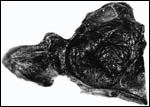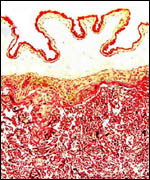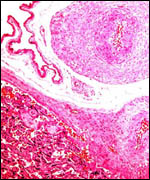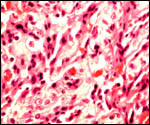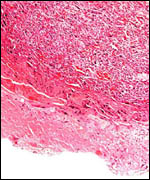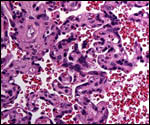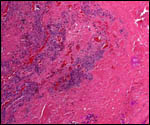| |
11)
Various features
No other remarkable endometrial features have been recorded.
12) Endocrinology
Soma and Kada (1989) stained their placentas with anti-hCG antibodies and
failed to demonstrate the presence of gonadotropins in that manner. Ziegler
et al. (1990), on the other hand, identified urinary chorionic gonadotropins
18 days after presumed ovulation, with elevated titers remaining to day
45 days. The polyestrous animals have a cycle of 22-24 days, estrus lasting
7 days. Other endocrine studies come from Carroll et al. (1990) and Ziegler
et al. (1990).
13)
Genetics
Goeldi's monkeys have typically 48 chromosomes (Bender & Mettler,
1960; Chiarelli, 1980). Initially, a XX/XO sex determining mechanism was
suspected (Hsu & Hampton, 1970). Subsequently the mystery was solved
when a chromosomal error was described in a male animal. It had a fusion
of the Y-chromosome to autosome # 23 (Dutrillaux et al., 1988). The animal
appeared to be normal. The publication gives details of chromosomal banding
patterns. A study of repetitive DNA provided additional support for the
current phylogenetic position of this species (Montagnon, et al., 1993).
Similar conclusions were also derived from the study of genes determining
the v. Willebrand factor (Chaves, et al., 1999). No hybrids have been
described.
14)
Immunology
No studies are known to me.
15)
Pathological features
Infarcts were present in two of the three placentas of stillborn fetuses.
Callithrichids, including Goeldi's monkey, are extremely susceptible to
infection with lymphocytic choriomeningitis virus (Asper et al., 2001).
It is transmitted by wild mice and can be fatal with hepatitis. Pseudotuberculosis
due to Yersinia pseudotuberculosis appears to be endemic at Jersey with
death resulting in some animals (Bielli et al., 1999).
16)
Physiologic data
I know of no data relevant to this section.
17)
Other resources
Few cell lines are available from CRES
through Dr. Oliver Ryder at: oryder@ucsd.edu
18)
Other remarks - What additional Information is needed?
It would be helpful to have an implanted placenta described and one of
live births. Moreover, the data on umbilical cord and endocrinology are
woefully inadequate.
Acknowledgement
The animal photograph of this chapter comes from the Zoological Society
of San Diego.
References
Asper, M., Hofmann, P., Osmann, C., Funk, J., Metzger, C., Bruns, M.,
Kaup, F.J., Schmitz, H. and Gunther, S.: First outbreak of callithrichid
hepatitis in Germany: genetic characterization of the causative lymphocytic
choriomeningitis virus strain. Virology 284:203-213, 2001.
Bender,
M.A. and Mettler, L.E.: Chromosome studies of primates. II Callithrix,
Leontocebus and Callimico. Cytologia 25:400-404, 1960.
Bielli,
M., Lauzi, S., Pratelli, A., Martini, M., Dall'Ara, P. and Bonizzi, L.:
Pseudotuberculosis in marmosets, tamarins, and Goeldi's monkeys (Callithrichidae/Callicominidae)
housed at a European zoo. J. Zoo Wildl. Med. 30:532-536, 1999.
Carroll,
J.B., Abbott, D.H., George, L.M., Hindle, J.E. and Martin, R.D.: Urinary
endocrine monitoring of the ovarian cycle and pregnancy in Goeldi's monkey
(Callimico goeldii). J. Reprod. Fertil. 89:149-161, 1990.
Chaves,
R., Sampaio, I., Schneider, M.P., Schneider, H., Page, S.L. and Goodman,
M.: The place of Callimico goeldii in the Callitrichine phylogenetic
tree: evidence from von Willebrand factor intron II sequences. Mol. Phylogenet.
Evol. 13:392-404, 1999.
Chiarelli,
A.B.: The karyology of South American primates and their relationship
to African and Asian species. Chapter 19, pp. 387-398 in, Evolutionary
Biology of the New World Monkeys and Continental Drift. R. Ciochon and
A.B. Chiarelli, eds. Plenum Press, NY 1980.
Dutrillaux,
B., Lombardi, M., Carroll, J.B. and Martin, R.D.: Chromosomal affinities
of Callimico goeldii (Platyrrhini) and characterization of a Y-autosome
translocation in a male. Folia primatol. 50:230-236, 1988.
Heltne,
P.G., Wojcik, J.F. and Pook, A.G.: Goeldi's monkey, Genus Callimico.
Chapter 4, pp. 169-210, in Ecology and Behavior of Neotropical Primates,
Vol. 1. A.F. Coimbra-Filho and R.A. Mittermeier, eds. Academia Brasileira
de Ciências, Rio de Janeiro, 1981.
Hsu,
T.C. and Hampton, S.H.: Chromosomes of Callithricidae with special reference
e to an XX-'XO' sex chromosome system in Goeldi's marmoset (Callimico
goeldii Thomas 1904). Folia primatol. 13:183-195, 1970.
Martin,
R.D.: Goeldi and the dwarfs: the evolutionary biology of the small New
World monkeys. J. Human Evol. 22:367-369, 1992.
Montagnon,
D., Crovella, S. and Rumpler, Y.: Confirmation of the taxonomic position
of Callimico goeldi (Paris). (Primates, Platyrrhini) on the basis
of its highly repeated DNA patterns. Compte rendu Acad. Sci. III 316:219-223,
1993 Nowak, R.M.: Walker's Mammals of the World. 6th ed. The Johns Hopkins
Press, Baltimore, 1999.
Soma,
H. and Kada, H.: Placentation of the Goeldi's monkey, Callimico.
31. International Symp. Erkrankungen der Zoo- und Wildtiere, Dortmund.
Akademie-Verlag, Berlin, pp. 93-98, 1989.
Ziegler,
T.E., Snowdown, C.T., Warneke, M. and Bridson, W.E.: Urinary excretion
of oestrone conjugates and gonadotrophins during pregnancy in the Goeldi's
monkey (Callimico goeldii). J. Reprod. Fertil. 89:163-168, 1990.
|
